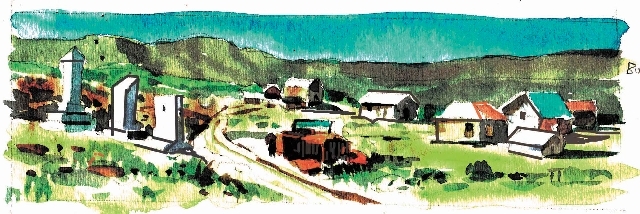California ghost town provides peek into past
Bodie — California’s most authentic ghost town — is preserved as a state historic park and a national historic landmark. Annually, thousands of visitors explore the former gold and silver boomtown. Maintained in a state of “arrested decay,” Bodie appears much as it did when the last residents left more than 50 years ago.
Open year-round, Bodie State Historic Park is located east of the Sierra Nevada peaks between scenic U.S. Highway 395 and the California-Nevada border. The turnoff onto Bodie Road, state Route 270, is seven miles south of Bridgeport. The route to the old town is paved for the first 10 miles. The last three miles of the road are unpaved and can be rough. The spring melt-off can make the road muddy and treacherous, and it is often impassable in winter.
Bodie sits at about 8,400 feet and receives heavy snow. Winter visitors often arrive on snowmobile, skis or snowshoes.
The summer is the most popular time to visit Bodie. The park is open from 9 a.m. to 6 p.m. daily during the summer (May 15 to Oct. 31). Winter hours are 9 a.m. to 3 p.m. Entering the park costs $7 for adults and $5 for children.
Visitors should be prepared to walk. Only part of the park is wheelchair accessible. From the parking lot at the end of the road overlooking the town, you must approach on foot. If the elevation or exertion bother you, find a porch to sit on and just enjoy the town’s ambiance.
Visitors follow a self-guided tour among the town’s remaining buildings. Furnished houses and commercial buildings still stocked with vintage wares appear as if people just hastily departed. Visitors are encouraged to peer through windows into a bygone era.
Bodie was born of a discovery of silver and gold ore in 1859, but not much came of it until a mine cave-in revealed real pay dirt in 1875. Many early claim holders sold to larger mining interests in 1877. Millions of dollars in gold and silver were removed from Bodie mines during the boom years. The population rapidly swelled to at least 8,500 and Bodie boasted 2,000 buildings by 1879, including at least 60 saloons and dance halls. The town attracted all kinds of people, including some very rough sorts who gave Bodie a reputation for lawlessness. Gunfights and other violent crimes filled up the town’s boot hill cemetery.
Of course, it was all short-lived. By 1886, the population had dropped to about 1,500. In 1892, a fire ravaged parts of Bodie and some buildings were never rebuilt. The town experienced a brief return to glory in the 1890s when mining became less costly. Bodie continued producing well into the 20th century. Disaster struck again in 1932 when another fire destroyed all but 10 percent of the town.
Bodie has no facilities for food, fuel, repairs, rescues or overnight stays. Visitors will find drinking water, picnic tables and flush restrooms at the parking lot and the in-town picnic area. Those who want to stay overnight or longer will have to return to Bridgeport or other small towns along U.S. 395 for lodging. There are also several national forest campgrounds within reasonable driving distance of Bodie.
A former union hall in the center of town now serves as a museum and bookstore run by the Bodie Foundation. This organization enhances the visitor experience with daily tours of an old stamp mill and Saturday mine tours. Available on a first-come basis, the daily tours cost $5, and the Saturday tours cost $7. Funds raised by the foundation support rehabilitation projects such as the current work on the railroad building that once served the Bodie and Benton Railroad. The museum is open from late May until mid-October.
Margo Bartlett Pesek’s column appears on Sundays.






















